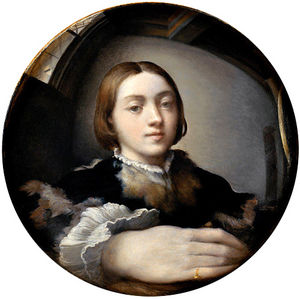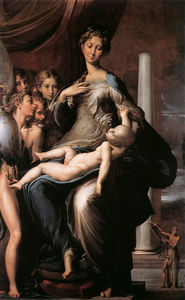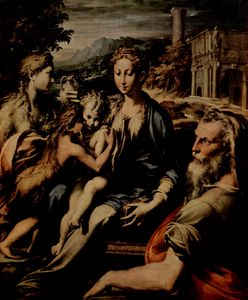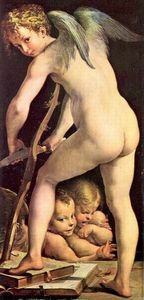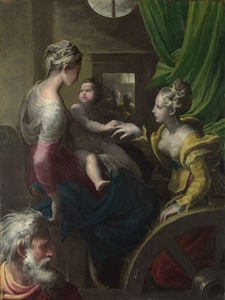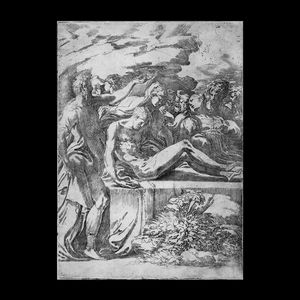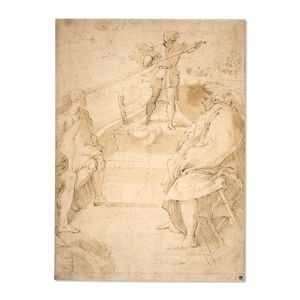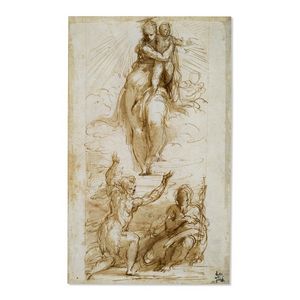Parmigianino Style and Technique
- Full Name:
- Girolamo Francesco Maria Mazzola
- Short Name:
- Parmigianino
- Alternative Names:
- Francesco Mazzola, Parmigiano
- Date of Birth:
- 11 Jan 1503
- Date of Death:
- 24 Aug 1540
- Focus:
- Paintings
- Mediums:
- Oil, Wood, Other
- Subjects:
- Figure, Scenery
- Art Movement:
- Mannerism
- Hometown:
- Parma, Italy
Parmigianino Style
Parmigianino had a huge stylistic influence on Mannerism and sixteenth-century graphic art generally. His art is renowned for its elegance and sensuality as well as its elongated figures, which often add a sense of movement and freedom.
Elongated figures:
Parmigianino's style is characterized by the lengthening of form, whether this is necks, limbs or shapes. Some of his artworks seem to be fixated by a sense of distortion, and as with many other Mannerist artists his work exaggerates the ideal beauty depicted by Raphael and other eminent Renaissance artists. Often the colors used are vivid and give an impression of tension and unreal lighting.
A bold artist, Parmigianino liked to experiment with unconventional compositions, but he was also praised for his classic Mannerism and as one of his biographers Vasari stated, he was 'celebrated as a Raphael reborn. ' Parmigianino successfully managed to blend a sensuous style with the classical style of Raphael.
Roman influence and religious paintings:
When Parmigianino moved to Rome he developed an elegant style of painting religious scenes and many commentators admired the sense of grace in his works. Yet, compared to Raphael's paintings of idealized classical beauty, Parmigianino developed a more artificial way of displaying nature.
At the time, Rome was going through a period of change; the atmosphere was tense and you can sense this in Parmigianino's work in its emotional intensity, distorted lighting and space and sensual themes. His extraordinary landscapes populated by daydreaming young beauties, charming babies and dignified old men seem to mask within them a tension, which forebodes a looming calamity. There is a sense of mystery to his paintings that requires the viewer to look beyond and question the serenity and aesthetic beauty on the surface. He often liked to include plays on reality and perception through his composition.
Sensuality:
The overt sensuality of some of Parmigianino's devotional paintings has led some critics to suggest that his work is blasphemous and disrespectful to the church and that he was a closet atheist. Many of his religious images have a sense of frivolous sensuality and because of this appear insincere and often seem to lack a sense of piety. Some of Parmigianino's work, in particular the graceful Madonna's, seems to navigate a difficult path between spiritual fulfillment and the more obvious visual pleasure in the image. They seem to be trying to capture and translate a set of differing meanings from a sense of the divine to aesthetic satisfaction and aristocratic etiquette.
Cupid Carving his Bow is a good example of the erotic nature evident in Parmigianino's paintings. It is hard to deny the homoeroticism in the image. Images like this and other images of male couplings may have just been for private amusement.
Spatial effects:
Instead of trying to imitate natural beauty he tried to look for a beauty beyond this. In his portraits you can often see that certain body parts are distorted, elongated or drawn from a unique perspective.
In many of his paintings you will also see a shifting between foreground and background, mirrors, changes in light and the use of very dark oils.
If you look at the painting The Mystic Marriage of Saint Catherine you will see evidence of these techniques and of his unusual compositions. At the centre is what looks like a mirror, but it could very well be a window. This sense of distortion and space is a common stylistic theme throughout his work.
Parmigianino Method
-

-

-

Ludovico Dolce in his Dialoghi, 1557
'Parmigianino gave his creations a certain loveliness that makes whoever looks at them fall in love with them. (He was) so delicate and accurate in his draughtsmanship that every drawing of his that is preserved on paper brings astonishment to the eyes of the beholder.'
Experimental etchings and new media:
Parmigianino was not afraid to experiment with new techniques and media and he was central to developing new styles of 16th century Italian graphic art. It is thought that he was one of the first Italian etchers and pioneers. Certainly, his work influenced the technology and art of printmaking and he recognized the potential of the graphic arts to be able to communicate and relay complex ideas. Parmigianino's involvement in printmaking also meant that his prints and copies of them were able to be extensively distributed, allowing his style and methods to be copied throughout Europe.
At the time, etchings were made by covering a copper plate with a waxy layer that is resistant to acid; the drawing is then freely scratched into this waxy layer. The copper plate is then submerged into a bath of acid and the acid then 'burns' into the plate where the drawing has been scratched. The image indented into the plate can then be easily printed off. It meant that prints could be made quickly by artists without the laborious training required to be a copperplate engraver.
However, not much was known about the potential of using different acids to create different effects as people did not have a vast knowledge about chemical features.
Parmigianino recognized this potential and devoted a great deal of time to discovering the artistic possibilities of this graphic technique. The results can be seen in the different effects evident in his work, from the various colors to the impressions and texture of his lines.
Chiaroscuro woodcut:
Always looking into different media, Parmigianino also experimented with another, new, printing technique: the chiaroscuro woodcut. This was the first color printing technique and allowed Parmigianino more freedom in his work. In the process, not one, but several colored blocks are used to build up a print. It is the reactions and play between these different blocks that produced such interesting tonal effects.
Drawings and sketches:
Parmigianino clearly loved drawing for its own sake. It is not just the sheer volume of his sketches that demonstrates this, but also the time spent drawing simple images, funny little scenes and portraits of animals. Other artists of the time would probably not have wasted their time on these trivial illustrations and so the time Parmigianino devoted to such drawings shows just how much of an imaginative artist he was.
He could easily sketch a complicated scene or portrait with just a few thin lines, and capture a movement or feeling with only a few light strokes. In his drawings and paintings, if you look closely, you will see that the subjects are often built up by layers of sketchy, hazy brushstrokes, emphasizing the artificiality of the artist's impression of nature.
Parmigianino also frequently worked with red chalk, which gave his work an energetic quality. He also used pen and ink, with and without brown washes. His use of shading often seems to be added in later to capture the fall of light and shade. The gentleness of some his etchings delighted many other contemporary artists who tried to imitate the fluidness of his lines.
Parmigianino talent shines through when he is concentrating on some specific detail in a scene, whether it is the draping of material or a muscular arm. He never seems to have been distracted by the model and always allowed his own interpretation to shine through.

